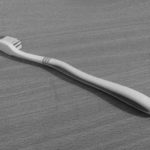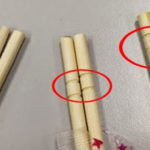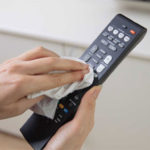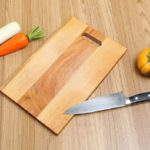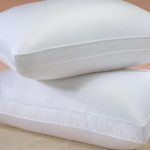Proper use of a cutting board can lead to better food quality. Additionally, using and maintaining your cutting board correctly not only prolongs its lifespan but also helps prevent potential health risks. Let’s find out if you’ve been using your cutting board correctly:
1. Using the Cutting Board Correctly
Avoid using an old cutting board

Once your cutting board starts to crack or develop grooves that are difficult to clean, it’s time to get a new one. These cracks and grooves can harbor bacteria, which is harmful to your health.
Don’t use both sides of the cutting board
It’s a common mistake to use both sides of the cutting board. However, the surfaces we use to support the cutting board, such as the floor or kitchen shelves, are often dirty. Placing the cutting board on these surfaces allows bacteria and germs to attach to the board. Therefore, it’s best to use only one side of the cutting board.
Don’t chop raw vegetables and meat on the same cutting board

Raw meat can easily harbor parasites, and the cooking temperature for vegetables is usually not high enough to kill these parasites. Some vegetables are even eaten raw. Using the same cutting board for both raw meat and vegetables can lead to cross-contamination, which is harmful to your health.
Avoid using a steel scrubber on the cutting board
Using a steel or metal scrubber to clean your cutting board can scratch the surface, creating a haven for bacteria. Instead, opt for a soft cloth to avoid scratches during the cleaning process. After scrubbing, remember to keep the cutting board upright to prevent water from seeping into the board and providing a breeding ground for bacteria.
Some tips for cleaning your cutting board after use

After using your cutting board, scrub it with some salt, and then use half a lemon to rub the surface. Alternatively, you can use dish soap and rinse with hot water to disinfect and kill mold. You can also use a vinegar solution to clean the cutting board by pouring vinegar on it, scrubbing with a sponge, and then rinsing with clean water.
Finally, wipe the cutting board dry and hang it in a dry and ventilated area to prevent mold. Avoid direct sunlight as it can cause the cutting board to crack and deform, affecting its lifespan.
2. Choosing the Right Cutting Board for Your Needs
Cutting boards come in various materials such as wood, plastic, and glass, each with its own advantages and disadvantages. Choose a material that suits your purpose, as each has unique properties.
Wooden Cutting Boards

Wooden cutting boards are the most traditional and common type used in many households. They are loved by home cooks for their durability.
Advantages: Wooden cutting boards are highly durable and heavy. Their hardness and sturdiness make them ideal for chopping meat and bones.
Disadvantages: Over time, wooden cutting boards can develop wood dust, cracks, and dampness, leading to mold. Cracks in the wood can absorb water, providing a breeding ground for harmful microorganisms.
Plastic Cutting Boards

Plastic cutting boards are the second most common type, addressing many of the drawbacks of wooden cutting boards.
Advantages: Plastic cutting boards are lightweight, waterproof, and do not produce wood dust or rot. They are perfect for slicing cooked foods and require less force.
Disadvantages: Plastic cutting boards cannot withstand high-impact forces and are not suitable for cutting fatty foods as they can be challenging to clean.
Glass Cutting Boards

Advantages: Glass cutting boards are made from tempered glass, so they don’t produce wood dust or oxidize. They are easy to clean, heat-resistant, and won’t scratch or scuff. Glass cutting boards are ideal for cutting fruits, vegetables, and soft foods like sushi rolls.
Disadvantages: The hard surface can dull knives, and the smooth surface can cause knives to slip, posing a safety hazard.
Now you know how to use and choose a cutting board correctly. If you’ve been making mistakes, it’s time to make adjustments to protect your health and improve food quality. Proper cutting board selection and maintenance are crucial for ensuring the health and well-being of your family!
8 Common Mistakes People Make with Cutting Boards
Are you using your cutting board correctly? Many Vietnamese households rely on cutting boards in their kitchen, but not everyone knows how to use them properly, especially when it comes to wooden cutting boards. Check out these 8 mistakes to avoid when using a cutting board to ensure both hygiene and safety for everyone in your family.

























